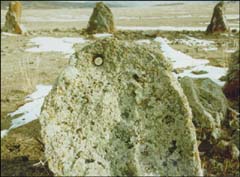 And then there is the name. For as long as anyone could
remember, the site was called "Ghoshun Dash", a Turkish
name meaning "Army Stone", probably because the complex looks
like an army of soldiers when seen from a distance. Parsamian
translated the name into Armenian, "Zorats Kar", but she couldn't
help but notice that a nearby village and locality was called
"Karahundj".
And then there is the name. For as long as anyone could
remember, the site was called "Ghoshun Dash", a Turkish
name meaning "Army Stone", probably because the complex looks
like an army of soldiers when seen from a distance. Parsamian
translated the name into Armenian, "Zorats Kar", but she couldn't
help but notice that a nearby village and locality was called
"Karahundj".
Parsamian
first noted the 'coincidence' of the Karahundj with its translation
into English, an Indo-European language like Armenian.
"The word
'Karahundj' is a complex word, made up of 'Kara' (from stone)
and 'hundj'. 'hundj' is very close to 'henge.' So
Kara-hundj translates into Stone-henge."
The tricky
part is 'henge' and 'hundj'. There are no modern equivalents
for these sounds in English or Armenian, both are ancient roots
that have evolved into other words over time.
Parsamian
adds, "The philologist Babkin Chukasian told me that in old
Armenian the word 'hundj' may have been 'pundj' which means
bouquet. Over time, we think they changed it to 'hundj'
which is very close to the English 'henge'. Gerald Hawkins
supposed that 'hundj' might be an old version of the word 'hung'
or 'hang', which would make Stonehenge 'hanging stones."
Herouni
thinks that "hundj" is a variant of the Armenian word for voice
('hunchuin'), and the name Karahundj means "Voice Stones" or
"singing stones". He notes that at the March equinox,
hundreds of people visit Stonehenge in England to listen to
the stones, as the winds whistle through them.
"Most people know England's Stonehenge, but there are others
in England, Scotland, Ireland, even in Iceland and Brittany.
One in the Hebrides is called 'Kalinish'. The first
part 'Kali' is close to the Armenian 'Kara'. And 'nish'
is a precursor of the Armenian 'n'shen' which translates into
'sign'. A town near another henge in England is named
"Karnak", but in old English it was "Karnish," which is close
to the Armenian for Stone Sign."
What is
fascinating to word buffs, whatever the real meaning of the
words, is that the first part is identical between Armenian
and English. "here you have two identical words in different
languages," Herouni says. "Stone and Kar. And the village
has had that name since anyone can remember. I don't think
its a coincidence. Logic tells me there has to be a single
source. This is Armenia's Stonehenge."
Parsamian
bristles at the idea. "There is only one Stonehenge," she says.
"It is in England. Yes, there are hundred's of 'megalithic'
monuments or henges in the world, which we find only in EuropeŚwe
don't find them in India, or in Egypt, even the Mesopotamian
Ziggurats were not built in this way---"
"But there
is only one Stonehenge."
|